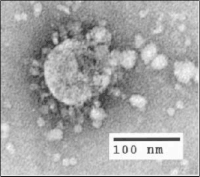
Photo from wikipedia
In April 2020, Belgium experienced high numbers of fatal COVID-19 cases among nursing home (NH) residents. In response, a mass testing campaign was organised testing all NH residents and staff.… Click to show full abstract
In April 2020, Belgium experienced high numbers of fatal COVID-19 cases among nursing home (NH) residents. In response, a mass testing campaign was organised testing all NH residents and staff. We analysed the data of Flemish NHs to identify institutional factors associated with increased SARS-CoV-2 infection rates among NH residents. Cross-sectional study was conducted between 8 April and 15 May 2020. Data collected included demographics, group category (i.e. staff or resident), symptom status and test result. We retrieved additional data: number of beds and staff, type of beds (level of dependency of residents) and ownership (public, private for profit/non-profit institutions). Risk factor analysis was performed using negative binomial regression. In total, 695 NHs were included, 282 (41%) had at least one resident tested positive. Higher infection rate among residents was associated with a higher fraction of RVT beds, generally occupied by more dependent residents (incidence rate ratio (IRR) 1.97; 95% CI 1.00–3.86) and higher staff infection rate (IRR 1.89; 95% CI 1.68–2.12). No relationship was found between other investigated NH characteristics and infection rate among residents. Staff-resident interactions are key in SARS-CoV-2 transmission dynamics. Vaccination, regular staff testing, assessment of infection prevention and control strategies in all NHs are needed to face future SARS-CoV-2 epidemics in these settings.
Journal Title: Epidemiology and Infection
Year Published: 2022
Link to full text (if available)
Share on Social Media: Sign Up to like & get
recommendations!